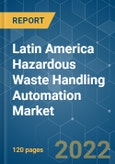Key Highlights
- The waste management industry witnessed a surge in demand for automation solutions, driven by the challenges posed by the COVID-19 pandemic. With the pandemic's control measures impacting businesses, travel, and manufacturing, the spotlight on efficient waste management intensified, given its critical role in public health.
- Stringent regulations, both from governments and industries, are fueling the growth of the hazardous waste handling automation market. These regulations aim to safeguard both people and the environment from the dangers posed by hazardous waste.
- Non-governmental and community-based organizations are collaborating with healthcare facilities to enhance medical waste collection, recycling, and disposal. Such collaborations not only address immediate needs but also drive the adoption of automation solutions in waste management.
- Hazardous waste, a byproduct of daily activities in households, power plants, and industries, demands careful handling. Automation solutions not only enhance efficiency but also reduce the risks associated with manual intervention, which is crucial given the potential dangers to human health. As safety concerns mount, the region is witnessing a parallel rise in the demand for automation in waste management.
- Recognizing the public health risks posed by hazardous waste, governments are increasingly focusing on regulations to ensure its effective treatment, recycling, and disposal, thus mitigating environmental pollution.
Latin America Hazardous Waste Handling Automation Market Trends
Growing Concerns About Waste Management Are Expected to Drive the Demand
- Hazardous waste, a byproduct of various industries, poses a significant threat to both the environment and human health. To combat the challenges posed by such waste, the global market for hazardous waste handling automation is witnessing a surge in demand, driven by a growing awareness of environmental issues and changing conditions.
- Within the manufacturing sector, a major contributor to global waste production, a substantial portion of generated waste contains hazardous chemicals. Disposal of these hazardous byproducts, ranging from paints and oils to batteries and reactive substances, demands meticulous attention.
- Improper handling and disposal of these hazardous wastes not only harm the environment but also pose direct risks to human health. This concern, coupled with the escalating waste production in the manufacturing sector, is propelling the market's growth.
- As the risks associated with direct human contact with hazardous waste become more apparent, the demand for automation solutions increases. Automation not only minimizes human exposure but also enhances operational efficiency.
- Effective waste management strategies involve segregating trash at its source, utilizing specialized waste processing facilities for material separation, and investing in waste-to-energy initiatives. These initiatives, including engineered landfill sites and energy generation from landfills through methane extraction or thermal treatments, are bolstering the demand for advanced waste-handling equipment.
Brazil is Expected to Witness Significant Growth
- As urban areas expand, so does the need for efficient waste management. Transitioning trash from smaller to larger trucks at transfer stations enhances collection and transport operations, especially in growing metropolitan areas.
- Garbage collection and transportation costs dominate the city's waste disposal expenses. By enhancing efficiency, cities can cut costs without compromising on service quality.
- The market is abuzz with new product launches, mergers, and acquisitions as vendors scramble to seize the opportunity. Key drivers behind these moves include the relentless adoption of new technologies, unlocking previously untapped commercial potential.
- In Brazil, the IKI project ProteGEEry has been pivotal, aiding 32 municipalities in bolstering their waste management. It also equips local decision-makers and technicians with a toolkit to enhance their capabilities.
- According to the World Bank, global waste generation is on an upward trajectory. In 2016, Latin America and the Caribbean collectively produced 231 million metric tons of waste. Projections indicate this figure could surge to 369 million metric tons by 2050.
Latin America Hazardous Waste Handling Automation Industry Overview
The Latin American hazardous waste handling automation market is consolidated due to the presence of both global players and small and medium-sized enterprises. Some of the major players in the market include PaR Systems Inc., Konecranes PLC, DX Engineering, Floatograph Technologies, and Pallmann. Players in the market are adopting strategies such as partnerships and acquisitions to enhance their product offerings and gain sustainable competitive advantage.- March 2024: Konecranes launched smart, connected industrial cranes to tap opportunities across multiple customer segments. Identical wireless upgrade capability offers customers more flexibility and provides Konecranes with unique business model opportunities.
- December 2023: In Q3 2023, Eldorado Brasil's new cellulose terminal in Port of Santos received seven forklifts and two gantry cranes from Konecranes. This marked the completion of the order, which also included joint planning and consulting on the layout of the terminal to ensure Eldorado gets the best business return for its significant investment.
Additional Benefits:
- The market estimate (ME) sheet in Excel format
- 3 months of analyst support
This product will be delivered within 2 business days.
Table of Contents
Companies Mentioned (Partial List)
A selection of companies mentioned in this report includes, but is not limited to:
- PaR Systems Inc.
- Konecranes PLC
- DX Engineering
- Floatograph Technologies
- Pallmann
- Hosokawa Micron Powder Systems
- ACE Inc.
- Terex MHPS GmbH
- Hiab
- PENZ Crane
Methodology

LOADING...








